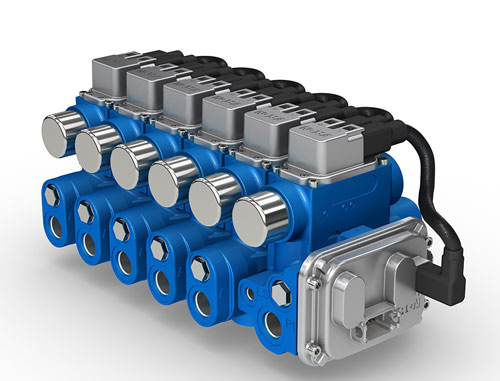The IFPE show in Las Vegas from March 7-11 will be an ideal place to learn about the latest in hydraulic valves. Here’s a description of how and why you use them in mobile machinery, as well as a listing at bottom of what IFPE booths to stop by for more information on valves.
Hydraulic valves, in addition to the force density advantage of actuators, are what help make hydraulics unique in their control of force, torque and motion. Valves govern direction, pressure and flow of hydraulic fluid, enabling smooth, safe and controlled use of actuators.
Every machine both requires and uses valves, varying vastly in execution from a few valves to dozens on one machine. Their use can be as simple as a relief valve to protect your pump and actuator, such as the relief valve built into the kick-off valve on a log splitter. Conversely, the complexity of a hydraulic circuit can be extensive, using a dozen valves per function as can be seen in manifolds, such as a pilot operated valve with dual counterbalance valves, dual flow controls, dual post-compensation and load sensing checks.
The directional control valve is available in myriad configurations, and is named as such because its primary function is to somehow control the path of fluid flow. The most basic directional valve is the check valve; it allows flow into one work port, and blocks flow from coming back through the opposite work port. Alternatively, directional valves can be as advanced as pilot operated proportional valves with internal pilots, drains and load sense check valves.
Directional valves are often described as the number of “ways” fluid can travel through itself, and also by the positions available to be shifted into. The ways are equal to the number of work ports, so a 4-way valve will have pressure, tank and A and B work ports. Positions are equal to the number of positional envelopes. For example, one would describe a double acting single-monoblock valve as “4-way, 3-position,” or simply a “4/3 valve.”
Directional valve are available in monoblock or sectional valves, common to the mobile-hydraulic industry, as well as subplate mounted industrial type valves such as ISO style D03’s, D05’s et al. Also common to both mobile or industrial markets are cartridge valves installed into manifold blocks. Cartridge valve manufacturers offer many unique products, and allow high levels of creativity with limitless available valve combinations.
Pressure valves are components designed to in some way limit pressure. Most pressure valves are based on a poppet being pushed against a seat with an adjustable spring. A relief valve controls maximum pressure for either the entire system or a sub-circuit of it, the lowest spring pressure being the one to open up first. Most other pressure valves are based on the relief valve’s simple spring-loaded ball or poppet. Sequence valves, counterbalance valves, and brake valves are all different forms of relief valves, with added utility or functionality, such as reverse flow checks or pilot operation built in. The pressure-reducing valve differs from the other pressure valves because it limits pressure downstream of itself, rather than upstream. It is used in applications where sub-circuit pressures need to be lower, without sacrificing any performance in the rest of the system.
Flow control valves are any component designed to control or limit flow in one way or another. Often simply a needle valve—which is just a variable restriction—adjusted by a screw or knob much like pressure valves, to limit the energy potential to create flow. When installed with reverse flow check valves, we change the name to flow control. Flow control valves can often have multiple ports, such as with a priority flow control. They are able to provide controlled, fixed flow to one part of the circuit, sometimes at the sacrifice of another part, and as long as input flow is high enough for its priority demand.
Flow controls are ideally pressure compensated, which allows the valve to maintain their set flow regardless of load-induced pressure variances. Pressure compensators are a type of flow control valve available as a single item, often added to other valves in a circuit to provide the same flow setting load-independent accuracy, such as with a proportional valve, for example.
Valve exhibitors and suppliers and IFPE
AAH Fluid Power S83046
ALA Industries/Yuken Hydraulics S82856
Argo-Hytos S83356
Bailey International S83240
Brevini Fluid Power S82218
Bucher Hydraulics S81916
Comatrol S80718
Delta Power Co. S82230
Deltrol Fluid Products S81420
Eaton S80230
FD-Groups America S83110
FluiDyne Fluid Power S80634
GS Global Resources S80654
Gurmaksan Hidrolik S83020
GW Lisk Co. S80620
HAWE Hydraulik S80529
HydraForce S80539
Hydrosila S82843
International FPA S83630
Italgroup SRL S83620
Lynch Fluid Controls S80739
MICO, a WASBO Co. S81520
MTE Hydraulics S81610
Muncie Power Products S82240
OEM Controls S81406
Poclain Hydraulics S81640
Prince Manufacturing Corp. S82920
Roquet Hydraulics S81306
Salami SpA S83601
Shivam Hydraulics S83739
Transaxle S82633
Tuson Corp. S83530
Weber-Hydraulik S83340


